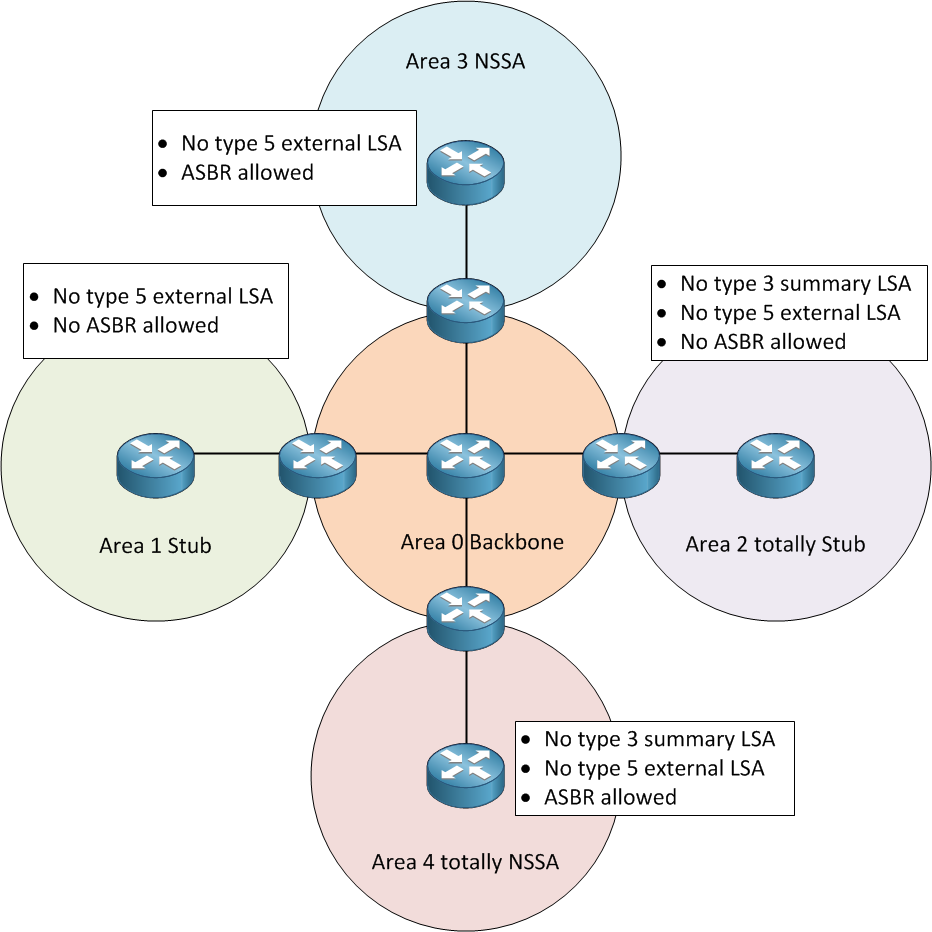OSPF has special area types called stub areas. In this lesson, I want to give you an overview of the different OSPF stub areas. Make sure you understand the different OSPF LSA types before you continue reading, or it might be difficult to follow me.
Let me start by summing up the special area types:
- Stub area
- Totally stub area
- NSSA (not so stubby area)
- Totally NSSA (totally not so stubby area)
Do you feel stubby now?
These special area types are used to insert default routes into an area and replace type 3 summary LSAs and type 5 external LSAs. This will keep the LSA flooding to a minimum, LSDB smaller, fewer SPF calculations, and a smaller routing table. Let me give you an overview of the different stub areas:

Let’s start with a nice topology with five areas. In the middle, you’ll find the backbone area, and the other areas are configured as different stub area types.
If you configure an area as a stub, it will block all type 5 external LSAs. All the prefixes you redistributed into OSPF from another routing protocol are not welcome in the stub area. Since you are not allowed to have type 5 external LSAs in the stub area, it’s also impossible to have an ASBR in the stub area. You can still learn networks from other OSPF areas.
Of course, there’s always an exception. So what if you want an area to be a stub area, but you also have an ASBR in this area? You can use the NSSA (not-so-stubby-area). This is the same thing as the stub area except that you are allowed to have an ASBR within the area. How does it work? This is where the type 7 external LSA kicks in. Since we are not allowed to use the type 5 external LSA, we’ll use a new LSA type.
What about totally stub? This area type will block type 5 external LSAs and type 3 summary LSAs. It’s impossible to have an ASBR in the totally stub area since type 5 external LSAs are blocked.
If you want to block type 3 summary LSAs and type 5 external LSAs but still need an ASBR within the totally stub area you can turn it into a totally NSSA (totally not-so-stubby-area). This will block both LSA types, but you can still have an ASBR in this area type.
Anything else you need to know? Here are some of the rules when dealing with the stub and totally stub areas:
- There should be at least one ABR in the area.
- All routers in the stub area have to be configured as a stub routers.
- There is no ASBR within the stub or totally stub area.
- The backbone area cannot become a stub or totally stub area.
I hope this overview is helpful to you. In another lesson, I’ll demonstrate how to configure these different stub areas!
Unit 1: Introduction to OSPF
- Introduction to OSPF
- Basic OSPF Configuration
- OSPF Multi Area Configuration
- OSPF Reference Bandwidth
- OSPF Plain Text Authentication
- OSPF MD5 Authentication
- OSPF SHA-HMAC Authentication
- OSPF TTL Security Check
- OSPF Default Route
Unit 2: OSPF Neighbor Adjacency
- OSPF LSA Types
- OSPF LSAs and LSDB Flooding
- OSPF Hello and Dead Interval
- OSPF Router ID
- OSPF Packets and Neighbor Discovery
- OSPF DR/BDR Election
- OSPF Passive Interface
- Troubleshooting OSPF Neighbor Adjacency
Unit 3: OSPF Network Types
- OSPF Non-Broadcast Network Type
- OSPF Broadcast Network Type
- OSPF Point-to-Multipoint Network Type
- OSPF Point-to-Multipoint Non-Broadcast Network Type
- OSPF Point-to-Point Network Type
- OSPF Next Hop with Network Types
Unit 4: OSPF Stub Areas
- Introduction to OSPF Stub Areas
- How to configure OSPF Stub Area
- How to configure OSPF Totally Stub
- How to configure OSPF NSSA (Not So Stubby) Area
- How to configure OSPF Totally NSSA (Not So Stubby) Area
- OSPF NSSA P-bit explained
Unit 5: Advanced OSPF Topics
- OSPF Summarization
- OSPF Distribute-List Filtering
- OSPF LSA Type 3 Filtering
- OSPF LSA Type 5 Filtering
- OSPF Virtual Link
- OSPF Virtual Link Authentication
- OSPF Path Selection Explained
- How to read the OSPF Database
- OSPFv3 for IPv4
- Troubleshooting OSPF Route Advertisement
- OSPF SPF Scheduling and Throttling
- OSPF LSA Throttling
- OSPF Incremental SPF
- OSPF Prefix Suppression
- OSPF Stub Router
- OSPF Graceful Shutdown
- OSPF Graceful Restart
- OSPF Loop-Free Alternate (LFA) Fast Reroute (FRR)
- OSPF Remote Loop-Free Alternate (LFA) Fast Reroute (FRR)